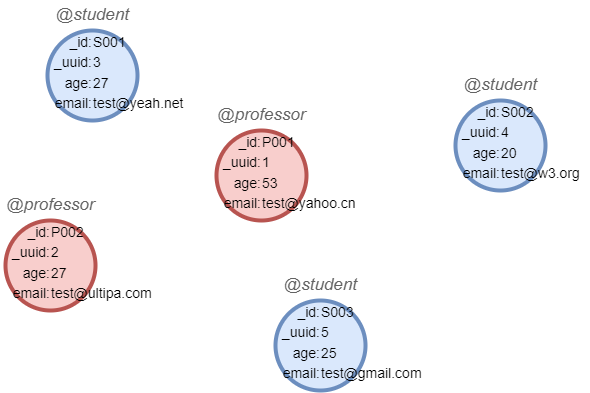- Expression:
<string>=~ "<regexp>" - Left operand: string
- Right operand: regular expression
Constant
Example: judge if String "adfAWa" is composed of uncapitalized letters
return "Ultipa" =~ "^[a-z]+$"
0
Function
Example: Convert 'Graph Database' to lowercase and judge whether it is composed of uncapitalized letters
return lower("Ultipa.com") =~ "^[a-z]+$"
0
Alias
Example: Judge each row of an alias whether it is composed of uncapitalized letters
uncollect ["Ultipa.com", "grAph", "graph"] as a
return a =~ "^[a-z]+$"
0
0
1
Sample graph: (to be used for the following examples)

create().node_schema("professor").node_schema("student")
create().node_property(@*, "age", int32).node_property(@*, "email", string)
insert().into(@professor).nodes([{_id:"P001",_uuid:1,age:53,email:"[email protected]"},{_id:"P002",_uuid:2,age:27,email:"[email protected]"}])
insert().into(@student).nodes([{_id:"S001",_uuid:3,age:27,email:"[email protected]"},{_id:"S002",_uuid:4,age:20,email:"[email protected]"},{_id:"S003",_uuid:5,age:25,email:"[email protected]"}])
Property
Example: Find nodes whose email is in format [email protected] or [email protected]
find().nodes({email =~ "^[a-zA-Z0-9_.-]+@[a-zA-Z0-9]+\.(com|cn)$"}) as n
return n{*}
|--------------- @professor --------------|
| _id | _uuid | age | email |
|-------|-------|-------|-----------------|
| P001 | 1 | 53 | [email protected] |
| P002 | 2 | 27 | [email protected] |
|---------------- @student ---------------|
| _id | _uuid | age | email |
|-------|-------|-------|-----------------|
| S003 | 5 | 25 | [email protected] |
Example: Find nodes of @professor, whose email is in format [email protected] or [email protected]
find().nodes({@professor.email =~ "^[a-zA-Z0-9_.-]+@[a-zA-Z0-9]+\.(com|cn)$"}) as n
return n{*}
|--------------- @professor --------------|
| _id | _uuid | age | email |
|-------|-------|-------|-----------------|
| P001 | 1 | 53 | [email protected] |
| P002 | 2 | 27 | [email protected] |

